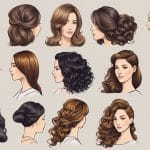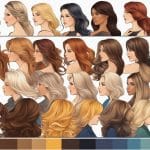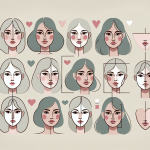Types Of Curly Hair
Curly hair comes in many different types and textures, and it can be challenging to understand the differences between them. Understanding your hair type is crucial when it comes to finding the right products and styling techniques that work best for you. In this article, we will explore the different types of curly hair and provide tips on how to care for and style each one.
One of the most important things to understand about curly hair is that it comes in a range of curl patterns. The most common types of curl patterns are wavy, curly, and coily. Each type has its own unique characteristics, and understanding your hair’s curl pattern is key to achieving healthy, beautiful curls. Additionally, hair texture and hair health play a significant role in how your curls look and feel.
Identifying your curly hair type is the first step in developing a hair care routine that works for you. Once you know your hair type, you can select products that are specifically designed for your curl pattern and hair texture. With the right care and styling techniques, you can enhance your natural curls and achieve the look you desire.
Understanding Curl Patterns

When it comes to curly hair, understanding the different curl patterns is essential in determining the right hair care routine. There are three main types of curl patterns: wavy, curly, and coily. Each type is further classified into subcategories based on the shape and size of the curls.
Type 2: Wavy Hair
Type 2 hair is characterized by an S-shaped pattern that is more defined than straight hair. It falls somewhere between straight and curly hair. Type 2 hair can be further broken down into three subcategories: 2A, 2B, and 2C. 2A curls are the loosest, while 2C curls are the tightest.
Wavy hair tends to be more prone to frizz than other hair types, so it’s important to use products that help tame frizz. A lightweight curl defining cream or mousse can help enhance waves and provide hold without weighing hair down.
Type 3: Curly Hair
Type 3 hair is characterized by well-defined, springy curls that range from loose to tight. Type 3 hair can be further broken down into three subcategories: 3A, 3B, and 3C. 3A curls are the loosest, while 3C curls are the tightest.
Curly hair tends to be more prone to dryness than other hair types, so it’s important to use products that provide moisture. A leave-in conditioner or hair oil can help keep curls hydrated and defined.
Type 4: Coily Hair
Type 4 hair is characterized by tightly coiled curls that range from fine and delicate to wiry and coarse. Type 4 hair can be further broken down into three subcategories: 4A, 4B, and 4C. 4A curls are the loosest, while 4C curls are the tightest.
Coily hair tends to be more prone to shrinkage than other hair types, so it’s important to use products that help elongate curls. A curl defining cream or gel can help provide hold and definition while also elongating curls.
In conclusion, understanding your curl pattern is crucial in determining the right hair care routine. By using products that cater to your specific curl type, you can enhance your natural curls and achieve healthy, beautiful hair.
Caring for Curly Hair
Curly hair can be beautiful, but it requires special care to keep it healthy and looking its best. To maintain healthy, bouncy curls, it’s important to focus on hydration, cleansing, conditioning, and styling. Here are some tips to help keep your curly hair looking its best.
Hydration and Moisture
Curly hair is naturally prone to dryness, so it’s important to keep it hydrated and moisturized. This can be achieved by using a variety of products, including hydrating conditioners, detanglers, leave-in conditioners, and styling products. Natural oils like coconut oil, jojoba oil, and argan oil can also be used to help moisturize curly hair.
Cleansing and Conditioning
When it comes to cleansing curly hair, it’s important to use a gentle shampoo that won’t strip the hair of its natural oils. Look for sulfate-free shampoos that are specifically designed for curly hair. It’s also important to condition your hair regularly to help keep it hydrated and healthy. Look for conditioners that are designed for curly hair and contain ingredients like shea butter, jojoba oil, and argan oil.
Styling and Maintenance
Styling curly hair can be challenging, but with the right products and techniques, it can be easy to achieve beautiful, bouncy curls. Mousse, gels, styling cream, and leave-in conditioner can all be used to help define curls and keep them looking their best. It’s important to avoid using heat styling tools like flat irons and curling irons, as these can damage curly hair and cause it to become dry and brittle.
In addition to using the right products, it’s important to establish a regular hair care routine for your curly hair. This may include weekly deep conditioning treatments, regular trims to prevent split ends, and protective styles like braids and twists to help keep your hair healthy and protected. By following these tips, you can help keep your curly hair looking its best and feeling healthy and hydrated.
Hair Texture and Hair Health
Curly hair comes in a variety of textures and types, each with its own unique characteristics. Understanding your hair’s texture is essential for maintaining its health and achieving the desired look. In this section, we will explore some of the essential aspects of hair texture and how it relates to hair health.
Porosity and Density
Porosity and density are two critical factors that determine the health of your hair. Porosity refers to how well your hair can absorb and retain moisture. High porosity hair absorbs moisture quickly but loses it just as fast, leading to dryness, frizz, and breakage. Low porosity hair, on the other hand, has difficulty absorbing moisture, leading to a buildup of oil and product.
Density, on the other hand, refers to the number of strands of hair on your head. High-density hair has more strands per square inch than low-density hair, which can make it appear fuller. However, high-density hair can also be more fragile and prone to breakage.
Elasticity and Breakage
Elasticity is another essential aspect of hair health. It refers to how well your hair can stretch and return to its original shape without breaking. Healthy hair should have good elasticity, which allows it to withstand heat styling, brushing, and other forms of manipulation.
Breakage is a common problem for curly hair, especially if it is dry or fragile. To prevent breakage, it’s essential to use gentle products and avoid over-manipulating your hair. Regular deep conditioning treatments can also help improve elasticity and reduce breakage.
In summary, understanding your hair’s texture and characteristics is essential for maintaining its health and achieving the desired look. By paying attention to factors like porosity, density, elasticity, and breakage, you can ensure that your curly hair stays healthy and beautiful.
Identifying Your Curly Hair Type
Curly Hair Typing System
Before diving into the details of how to identify your curly hair type, it is important to understand the curly hair typing system. The most commonly used curly hair typing system is the Andre Walker Hair Typing System, which categorizes hair into four types: Type 1 (straight), Type 2 (wavy), Type 3 (curly), and Type 4 (coily).
Type 1 hair is straight and lacks any curl pattern. Type 2 hair is wavy, with subcategories of 2A, 2B, and 2C, with 2A being the loosest wave pattern and 2C being the tightest. Type 3 hair is curly, with subcategories of 3A, 3B, and 3C, with 3A being the loosest curl pattern and 3C being the tightest. Type 4 hair is coily, with subcategories of 4A, 4B, and 4C, with 4A being the loosest coil pattern and 4C being the tightest.
Factors Influencing Curl Types
Several factors can influence a person’s curl type, including genetics, hair texture, and hair type. Genetics plays a significant role in determining a person’s curl type, as it determines the shape and size of the hair follicle. Hair texture, which refers to the thickness and diameter of individual hair strands, can also influence curl type. Thicker hair strands tend to produce tighter curls, while thinner hair strands produce looser curls.
Hair type can also influence curl type. For example, wavy hair types tend to have a more relaxed curl pattern than curly or coily hair types. Additionally, hair porosity, which refers to the hair’s ability to absorb and retain moisture, can also affect curl type. Hair with high porosity tends to have a looser curl pattern, while hair with low porosity tends to have a tighter curl pattern.
Identifying your curly hair type is an important step in developing a hair care routine that works for you. By understanding the factors that influence curl type and the different types of curly hair, you can develop a hair care routine that will keep your curls healthy and beautiful.
Curly Hair Challenges and Solutions
Managing Frizz and Volume
Curly hair can be prone to frizz and volume, which can make it difficult to style. To manage frizz, it is important to use products that provide hydration and moisture to the hair. This can include hydrating shampoos and conditioners, as well as leave-in conditioners and styling products that contain oils and other moisturizing ingredients.
Another way to manage frizz is to avoid over-styling the hair. This can include minimizing the use of heat tools like blow dryers and flat irons, and avoiding brushing the hair too much. It is also important to protect the hair from humidity, which can cause frizz to worsen. This can be done by using anti-humidity products or wearing a hat or scarf on humid days.
To manage volume, it is important to choose the right haircut and styling techniques. Layers can help to reduce volume, while styling with a diffuser can help to enhance curls while minimizing volume. It is also important to avoid using heavy products that can weigh down the hair and make it appear flat.
Tackling Dryness and Tangling
Dryness and tangling are common challenges for curly hair. To combat dryness, it is important to use hydrating products that provide moisture to the hair. This can include hydrating shampoos and conditioners, as well as leave-in conditioners and styling products that contain oils and other moisturizing ingredients.
It is also important to avoid over-washing the hair, as this can strip the hair of its natural oils and cause it to become dry and brittle. Instead, it is recommended to wash the hair every few days or as needed, and to use a gentle shampoo that is specifically formulated for curly hair.
To tackle tangling, it is important to use a wide-tooth comb or a detangling brush to gently remove knots and tangles from the hair. It is also important to avoid brushing the hair when it is wet, as this can cause it to become more tangled. Instead, it is recommended to use a leave-in conditioner or detangling spray to help ease out tangles. Additionally, it is important to protect the hair while sleeping by using a silk or satin pillowcase, which can help to prevent tangling and breakage.






